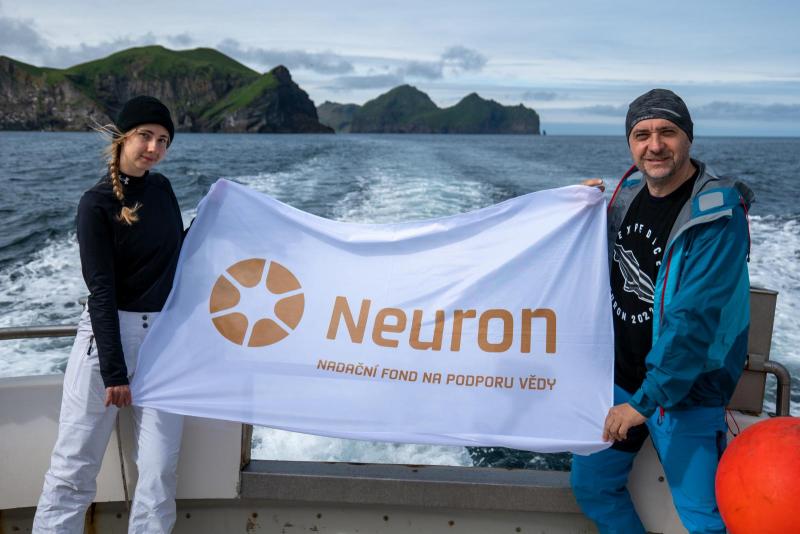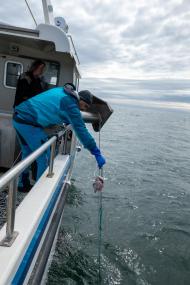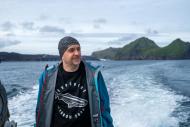Topic
Why does the Greenland shark live to be 400 years old? Scientists from FCH BUT want to discover the longevity gene

Some species of whales and turtles live to be up to 150 years old. However, their score is several times higher than that of the Greenland shark, which has lived in the cold waters of the North Atlantic for an impressive 400 years. But its genome is a big unknown for scientists. Therefore, a scientific expedition led by Professor Václav Brázda from the Faculty of Chemistry of the BUT and the Institute of Biophysics of the CAS (Czech Academy of Sciences) went to Iceland to search for it. With only one goal – to decipher the gene of its longevity.
The August expedition to the Icelandic island of Heimaey, supported by the Neuron Foundation, did not start smoothly. Five researchers from the University of Technology and the University of Ostrava were surprised shortly after their arrival by a strong earthquake and the subsequent eruption of a nearby volcano. The number of days spent on the ocean was complicated by a strong storm that made it impossible to sail during our stay.
Another obstacle was the actual capture of the Greenland shark, which was last caught here for oil in 1928. “There is no one alive who has practical experience of hunting it. We therefore contacted all sources – the nearby museum of underwater animals, local fishermen and the grandson of the last hunter,” explains molecular biologist and leader of the expedition Václav Brázda. Due to bad weather, they were unable to catch a live Greenland shark.

“Fortunately, we obtained tissue samples of this rare parrotfish, which can grow up to 7.5 metres long, from local fishermen. By coincidence, this shark accidentally got stuck in their fishing net a few days ago and they kept it. We then received additional tissue samples from a local university that specializes in whale studies and also had older samples of the Greenland shark,” Brázda says. The material needed for the shark DNA research was finally secured with the help of the locals.
The genetic focus now is on a specific homologue of the P53 protein, which protects cells from cancer. “We have studied the association of this protein with the lifespan of all the animals whose genomes we have in our database. DNA sequencing revealed that the nature of the protein differs in short- and long-lived animals,” explains Brázda. However, no database so far contains the genome of the Greenland shark, which has lived a record 400 years. “Its life expectancy is extreme. There must be something special in its genome that has so far escaped the attention of scientists,” Brázda points out.
“We have several hypotheses about the P53 protein – if the protein is too active, cells age faster. In the DNA of the Greenland shark, the homologue of the protein apparently has a different sequence that not only prevents the development of cancer or degenerative diseases, but also slows down cell ageing,” adds Brázda. Another hypothesis that scientists want to test is the influence of an enzyme called telomerase. It may be more active inside the Greenland shark, causing its cells to divide after 300 to 400 years, which other organisms are not capable of doing.
There may be a number of factors causing the longevity of the rare parrotfish. This includes the environment – the metabolism of an animal living in a very cold environment is slower, and so its cells age more slowly.

“However, this hypothesis is challenged by the fact that there are four other shark species living in the same place, which live to a maximum of 50 years. But genes are a complex thing – you can't say that any gene is good or bad. Under certain conditions – for example, extreme cold – certain genes may prove more advantageous for a particular animal,” explains Brázda.
Scientists have now sent the shark samples to South Korean laboratories, where researchers will sequence the DNA. The process takes them 2–3 months. “Processing huge amounts of sequencing data is challenging. For example, if we were to enlarge human DNA from a single cell to the width of a spiral staircase, it would lead from the Earth to the Moon. It is impossible to go through the entire staircase and find relevant information without tools that process big data. The shark genome is also longer than the human genome,” he notes.
However, the Greenland shark is specific not only in its lifespan. Until its death it was in excellent condition. Its cells remain relatively healthy at all times and are able to retain all functions. “Even more than longevity, we are interested in the mechanisms that allow cells to regenerate and function properly even at an advanced age,” explains Brázda.
Despite the fact that the research is still at an early stage, scientists believe that successfully deciphering the genome of the mysterious parrotfish could be beneficial to humans – whether by understanding the mechanism that prevents the development of neurodegenerative diseases, including cancer, or for drug development. “And maybe by doing so, we can help to ensure that people can live a quality active life even in old age,” he predicts a promising continuation of further research.
Professor Václav Brázda and his team want to return to the Icelandic island of Heimaey next year. “The DNA we brought back is of sufficient quality for sequencing. But we also need to get ribonucleic acid to help us resolve the transcriptome, or the active part of the genome. However, it decomposes much faster and needs to be removed from a live shark. We have already agreed with colleagues there to take RNA samples in a special way in case of another accidental detection,” says the professor.
The next expedition in search of the mysterious Greenland shark is expected to take place in the spring of 2023, when local fishermen say the shark is more likely to be found near the island. “We would like to stay at the site for a longer period of time to increase the likelihood of a successful hunt. Ideally, we want to capture sharks of different ages so that we can find out whether there are changes in the regulation of their genes even during their lifetime,” Brázda outlined plans to continue the research.
(mar)
Nilmore's circular clothing allows you to use the fibre repeatedly
Cheaper, better quality and eco-friendly. FCH BUT researchers create new dextrin adhesive
Experiment from FCH BUT shows that bioplastics are not always the greener choice
They were looking for a way how to supress the negative effect of zinc on cement. They developed a material with even better properties
Research from FCH BUT has contributed to a better understanding of cement-free concrete. The finding were also published in prestigious journals

